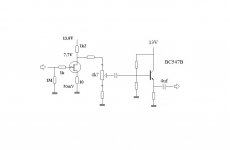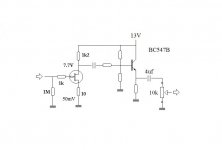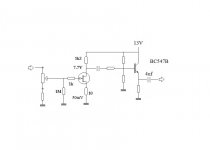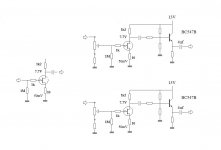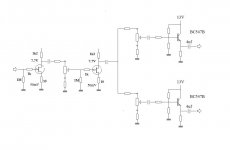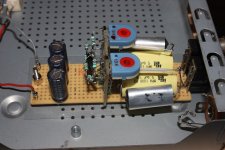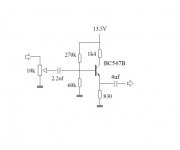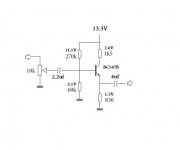Can try it like that, in that position the 2 additional resistors should be relatively high value. Then I would suggest trying to move the attenuator to after 4 uf at the output side. Maybe a 10K or 50 K pot.. the output impedance is related to the emitter resistance in parallel with the pot. So it is still low. Are you getting about a volt of signal swing at the jfet output? You will probably want all of that going into the BJT buffer , instead of attenuating it. Will keep noise lower. My humble suggestions only..keep playing around with it and hope your having fun!!
.... output impedance is related to the emitter resistance in parallel with the pot. So it is still low.
ahhh, ofcourse....simple emitter follower
I understand you better now
good info
thanks
Do not pass DC through the pot.
sounds like the pot is in the wrong position, with the simple bjt emitter follower
and since the simple emitter follower will work well having a pot on its output, like shanx suggested, that is what Im going to try
Attachments
Hi Tinitus, if your bass has a volume control (which I assume you do) you don't need the pot at the input. Adding another attenuator (parallel with you bass volume control) at input will defeat the purpose of the Hi Z input. Your previous schem will do what you need and you can drive your circuitry down the line to a level that suits them.
but maybe I dont need the BJT buffer at all
it was just to see if it would work
and I read its good driver with low output impedance
I guess ideally, the Hi Z jfet should be integrated on-board with the instrument
and in such case, the preamp with att at input would be fine
it was just to see if it would work
and I read its good driver with low output impedance
I guess ideally, the Hi Z jfet should be integrated on-board with the instrument
and in such case, the preamp with att at input would be fine
managed to 'arrange' caps between att pot and buffer
and it works...humm is now gone
only a modest snerring coming from instrument remains yet to be fixed
oh, btw, completely forgot about it
was hoping it would also be a good home for simple 12db line out crossover
thanks for your patience
cheers
and it works...humm is now gone
only a modest snerring coming from instrument remains yet to be fixed
oh, btw, completely forgot about it
was hoping it would also be a good home for simple 12db line out crossover
thanks for your patience
cheers

Attachments
why does "slightly simpler" need three attenuators?or slightly simpler
why does "slightly simpler" need three attenuators?
Each with un-needed extra resistors all round them?.
Although I think the idea of the multiple pots is a master volume, and separate output volumes on the two output channels.
But the main problem is trying to design a circuit knowing next to nothing about electronics, and essentially just 'guessing' configurations and values.
FET, master volume, single buffer transistor, two output pots (4.7K off that buffer) - job done).
why does "slightly simpler" need three attenuators?
one controls gain
one controls a woofer
one controls mid/tweeter
buying active xo would automaticly give me the two output attenuators
or a 2-channel PA power amp
one single jfet, and done.....
and I will probably try that too
just to experience how it works
Hi Tinitus, I figure that with 2 jfet stages preceding instead of one, that you had quite a bit of signal gain going on. On the emitter follower buffer did you stay with 830 ohm when making changes? Nigel also suggested putting the two attenuators after the emitter follower, with just master volume at the preamp. That is the ideal spot. As I mentioned earlier, the e-follower has or should have enough current drive to handle your loading of filter circuits, attenuators etc..changing resistors, with no result
Build active xo: just suggestion, but it's only two way xover so not too hard with opamps. you already have power supply, box hardware and buffered preamp, maybe $10 of parts for a simple one.
If you are thinking of running your preamplifier to a mixer board or any professional PA power amp, strongly suggest balanced line out XLR. Use DRV line driver chip to do this. Major advantage is you greatly diminish chances of introducing ground loop hum from equipment on different ac power circuits.
Hope you have fun!
active xo..... maybe $10 of parts for a simple one.
....balanced line out XLR. Use DRV line driver chip to do this.
Hope you have fun!
balanced line out would be good for PA poweramp
it was my hope to try build a chip amp
just for a tweeter, with integrated active xo
Hope you have fun!
when it works
 thanks
thanksbtw, I have a single jfet Hi-Z preamp, with no attenuator
even driving my poweramp(s) directly, it had way too much gain
might work ok, now that I have a buffer with output control
There have been many people posting the instrument/amps section, looking to do the preamp/chipamp combination. If you are also looking at that option (for home practice etc), go for it. IMHO most of the characteristic sound of that combination should come from a really well built preamp section, and the chipamp role being to give a neutral amplification of the preamp sound. There are a few parameters that could be manipulated at the chip amp section, but if you are also sending the preamp signal to a mixing board or PA, I presume you will want to have similar sound there as well.
A lot of commercial small practice amps and even larger SS amps are now using chipamps as the power section, but I find they are completely lacking a lot of potential in the preamp section, so I hope working on the pre you get that sound you are after.
A lot of commercial small practice amps and even larger SS amps are now using chipamps as the power section, but I find they are completely lacking a lot of potential in the preamp section, so I hope working on the pre you get that sound you are after.
- Status
- This old topic is closed. If you want to reopen this topic, contact a moderator using the "Report Post" button.
- Home
- Live Sound
- Instruments and Amps
- Switchable Hi-Z input impedance, how ?
